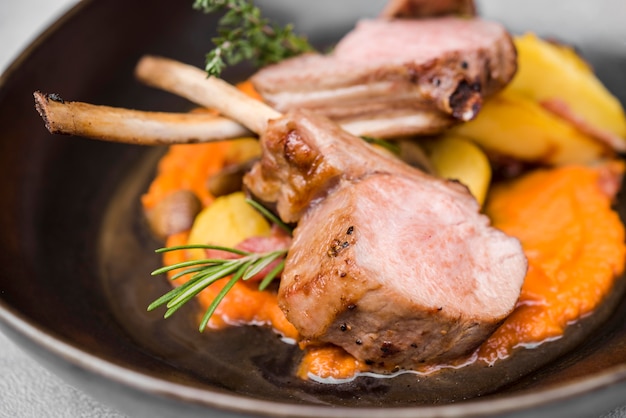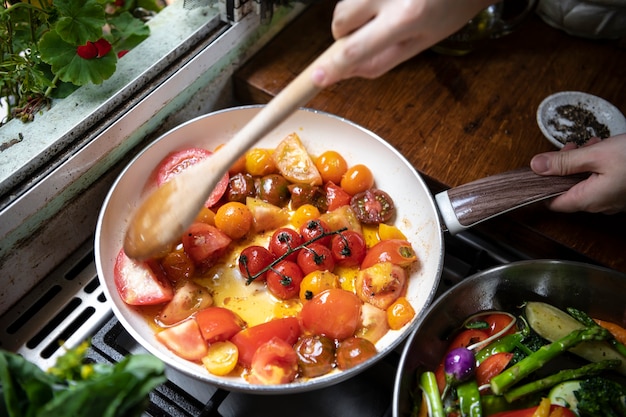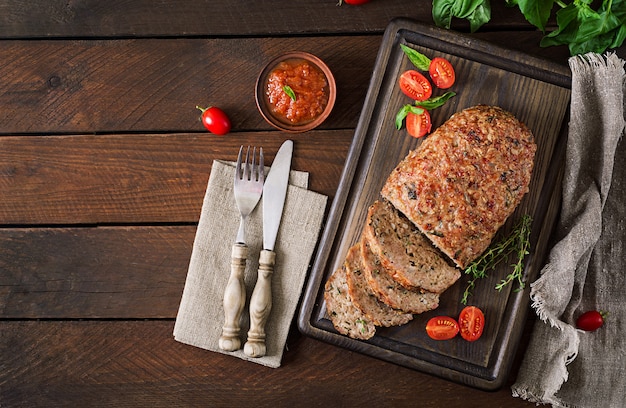pork roasts are a staple in many kitchens, bringing a comforting aroma and a hearty meal to the table. But getting a 2 lb pork roast cooked perfectly can seem like a bit of a mystery. Will it be dry? Will it be undercooked? Don't worry, I'm here to demystify the whole process and guide you to roast-making success.
This guide will be your go-to resource for cooking a 2 lb pork roast. We'll cover everything from choosing the right cut, prepping it for cooking, and mastering different cooking techniques to ensure a tender, juicy, and flavorful result. I'll also share my personal experiences and tips, along with some common questions and answers to help you along the way.
(Part 1) Choosing Your Pork Roast: The Foundation of Flavor

The first step to a delicious pork roast is choosing the right cut. There's a whole world of pork cuts out there, but for a 2 lb roast, these are some of the best options:
pork shoulder: The Classic Choice
Pork shoulder is a real workhorse. It's known for its rich, savory flavor and incredible tenderness after slow cooking. The fat melts away, leaving you with succulent, melt-in-your-mouth meat. It's the classic choice for a reason!
pork loin roast: Lean and Delicious
For those who prefer a leaner cut with a more delicate flavor, the loin is a great choice. It's perfect for quick cooking methods like roasting or grilling. It also tends to have a more tender texture compared to the shoulder.
pork tenderloin: The Smaller, More Delicate Option
Pork tenderloin is a smaller, more delicate cut that's perfect for smaller gatherings or even as a side dish. It cooks quickly and stays beautifully moist, making it a great choice for beginners.
Pork Butt: A Misnomer
Don't let the name fool you! The pork butt is actually taken from the shoulder. It's a larger cut, typically weighing 4-6 pounds, but you can easily make a smaller 2 lb roast by trimming the excess fat and meat.
My Choice: The Humble Pork Shoulder
Personally, I love the pork shoulder. It's so forgiving, even if you're not a seasoned chef, and the flavor after a slow roast is simply divine. I love the way it breaks down beautifully, and the rich, fatty flavor makes it irresistible.
(Part 2) Preparing Your Pork Roast: Setting the Stage for Flavor

Once you've chosen your perfect cut, it's time to get it ready for the oven. Here's how to prep your pork roast for deliciousness:
1. Trimming the Fat: A Matter of Preference
First, trim any excess fat. Some people prefer to leave a layer of fat for extra flavor and moisture, but I find that trimming it down to about ?? inch results in a less greasy roast and a crispier outer layer.
2. Seasoning the Roast: Unleashing Flavor
Now comes the fun part: seasoning! I love to keep it simple with salt, pepper, and garlic powder, but feel free to experiment. Paprika, rosemary, thyme, or even a touch of chili powder can add incredible depth of flavor.
3. Scoring the Roast: (Optional)
Scoring the roast is a great way to create a crispy skin and allow the seasonings to penetrate deeper into the meat. Use a sharp knife to make shallow cuts across the surface of the roast, about ?? inch apart.
(Part 3) Cooking Your Pork Roast: Two Popular Methods

There are two main ways to cook a pork roast: oven roasting and slow cooking. Each method brings its own unique charm and flavor profile.
Oven Roasting: The Classic Approach
This method is perfect for achieving a beautiful, golden-brown crust. Here's how to roast your pork roast to perfection:
1. Preheat Your Oven: A Vital Step
First, preheat your oven to 350°F (175°C). A hot oven ensures even cooking and helps create a crispy exterior.
2. The roasting pan: A Spacious Home for Your Roast
Place your seasoned pork roast in a roasting pan. A pan slightly larger than the roast will give it room to cook evenly.
3. Adding Liquid: Keeping Your Roast Moist
Here's a crucial step: adding liquid to the pan. It helps keep the roast moist and prevents it from drying out. chicken broth or apple cider are my favorites, but water works just fine.
4. roasting time: The Countdown Begins
Place the roast in the oven and cook for 1 hour and 15 minutes, or until the internal temperature reaches 145°F (63°C).
5. Rest Time: The Secret to Tenderness
Once the roast is cooked, remove it from the oven and let it rest for 15 minutes before carving. This allows the juices to redistribute, resulting in a more tender and flavorful roast.
Slow Cooking: The Ultimate Tenderness
Slow cooking is perfect for achieving a melt-in-your-mouth pork roast. Here's how to slow cook your pork roast to perfection:
1. The slow cooker: A Cozy Home for Your Roast
Place your seasoned pork roast in your slow cooker. Don't overcrowd the cooker; leave some space around the roast for even cooking.
2. Adding Liquid: The Key to Moisture
As with oven roasting, adding liquid is crucial. I love a mixture of chicken broth, apple cider, and a splash of soy sauce for an extra depth of flavor.
3. Cooking Time: Slow and Steady Wins the Race
Set your slow cooker to low and cook for 6-8 hours, or until the meat is incredibly tender and falls apart easily.
4. Rest Time: A Final Touch of Tenderness
Once the roast is cooked, remove it from the slow cooker and let it rest for 15 minutes before carving.
(Part 4) Temperature Guide: A Safe and Flavorful Roast
Knowing the right cooking temperature is vital to ensure a safe and delicious pork roast. Here's a quick guide:
Internal Temperature: Your Roast's Guide
Safe Minimum: 145°F (63°C) - This is the minimum internal temperature recommended by the USDA for pork to ensure it's safe to eat.
Ideal Temperature: 150°F (65°C) - For a juicy and flavorful roast, aim for this temperature.
Cooking Time: A General Guideline
2 lb Roast: 1 hour and 15 minutes (oven roasting) or 6-8 hours (slow cooking)
Remember, cooking times can vary depending on your oven, slow cooker, and the thickness of the roast. Always use a meat thermometer to ensure your pork is cooked to perfection.
(Part 5) Checking for Doneness: How to Know When Your Roast Is Ready
You've got your roast in the oven or slow cooker, but how do you know when it's ready? Here are several ways to check for doneness:
1. The Meat Thermometer: Your Reliable Guide
A meat thermometer is the most reliable way to check for doneness. Insert it into the thickest part of the roast, making sure it doesn't touch any bone. When the temperature reaches 145°F (63°C), your roast is ready!
2. The Touch Test: A Gentle Approach
If you don't have a thermometer, try the touch test. Gently poke the roast with a fork. If the meat is tender and gives way easily, it's likely cooked.
3. The Juice Test: A Visual Check
Make a small incision in the roast. If the juices run clear, the roast is cooked. If they're pink or bloody, it needs more time in the oven.
(Part 6) Serving Your Pork Roast: Bringing Your Meal to Life
You've cooked your pork roast to perfection, now it's time to enjoy the fruits of your labor. Here are some serving ideas to make your meal even more special:
1. Carving: The Art of Cutting
Once your roast has rested, it's time to carve. Start by slicing the roast against the grain, which means cutting across the muscle fibers. This makes the meat more tender and easier to chew.
2. Sauces and Gravies: A Flavor Boost
A delicious sauce or gravy can elevate your pork roast. Use pan juices from the roast to create a simple gravy, or get creative with apples, onions, or mustard for a more elaborate sauce.
3. Sides: The Perfect Complements
No pork roast meal is complete without tasty sides. Here are some of my favorites:
Roasted vegetables (like carrots, parsnips, or sweet potatoes)
Cornbread
Applesauce
4. Presentation: The Finishing Touch
Don't forget about presentation! Arrange your carved pork roast on a platter with your chosen sides. Add a sprig of fresh rosemary or thyme for a touch of elegance.
(Part 7) Leftovers: Don't Throw Them Away!
Leftover pork roast is a true blessing! It can be used in a variety of dishes, like:
1. Sandwiches: A Classic Use
Slice the leftover roast and use it to make delicious sandwiches. Try it with mustard, pickles, and a slice of tomato for a classic combination.
2. Soup: A Hearty and Flavorful Meal
Chop up the leftover roast and add it to a base of chicken broth, vegetables, and your favorite spices for a hearty and flavorful soup.
3. Stir-Fry: A Quick and Easy Dinner
Dice the leftover roast and add it to your next stir-fry for extra protein and flavor.
4. Pizza: A Creative Topping
Shred the leftover roast and use it as a topping for your next pizza. It pairs perfectly with cheese, onions, and a tangy sauce.
(Part 8) FAQs: Answering Your Pork Roast Questions
1. Can I Cook a Pork Roast From Frozen?
It's not recommended to cook a pork roast from frozen. It will take longer to cook and may not be as evenly cooked. Thaw it in the refrigerator overnight before cooking.
2. What's the Best Way to Thaw a Pork Roast?
The safest and most convenient way to thaw a pork roast is in the refrigerator. Place it on a plate in the refrigerator and allow it to thaw for 24 hours. Avoid thawing at room temperature, as it can encourage bacterial growth.
3. Can I Overcook a Pork Roast?
Yes, overcooked pork will be dry and tough. Cook it to the correct internal temperature and rest it for 15 minutes before carving.
4. How Long Can I Keep Leftover Pork Roast in the Fridge?
Leftover pork roast can be stored in the refrigerator for 3-4 days. Store it in an airtight container and refrigerate it immediately after cooking.
5. Can I Freeze Leftover Pork Roast?
Yes, wrap it tightly in plastic wrap and then place it in a freezer-safe bag. It can be frozen for 2-3 months.
(Part 9) Conclusion: Master the Art of pork roasting
Cooking a 2 lb pork roast to perfection is within your reach. Remember: choose the right cut, prep it well, and cook it to the correct temperature. With a little practice and these tips, you'll be creating mouthwatering pork roasts that will impress everyone at your table.
So go ahead, fire up the oven or slow cooker, and get ready to experience the joy of a perfectly cooked pork roast! Happy cooking!
Everyone is watching

Corn on the Cob: The Ultimate Guide to Perfectly Cooked Ears
Healthy MealsAh, corn on the cob. Just the name evokes images of sunny days, barbecues, and that sweet, juicy flavour that ...

Scallops: The Ultimate Guide to Perfect Cooking
Healthy MealsAh, scallops. Those delicate, sweet, and utterly delicious morsels of the sea. They hold a special place in my...

Spaghetti Squash: The Ultimate Guide to Cooking and Serving
Healthy MealsRemember that time you saw spaghetti squash at the supermarket, looking all bumpy and strange, and thought, "W...

Salmon Cooking Times: Perfect Guide for Every Recipe
Healthy MealsLet me tell you, cooking salmon is an art form. It's all about getting that perfect balance: juicy and tender,...

Ham Cooking Time: How Long to Bake, Smoke, or Boil a Delicious Ham
Healthy MealsAh, ham. It's a classic, isn't it? A real crowd-pleaser, especially around holidays. And when done right, it'...
